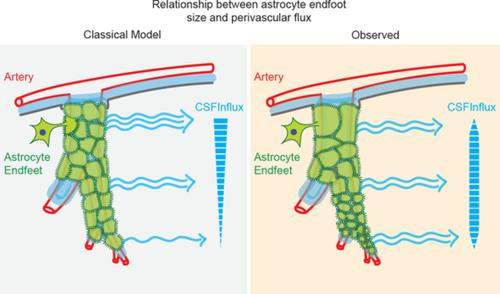Our official English website, www.x-mol.net, welcomes your
feedback! (Note: you will need to create a separate account there.)
Varying perivascular astroglial endfoot dimensions along the vascular tree maintain perivascular‐interstitial flux through the cortical mantle
Glia ( IF 5.4 ) Pub Date : 2020-10-19 , DOI: 10.1002/glia.23923 Marie Xun Wang 1, 2 , Lori Ray 3 , Kenji F Tanaka 4 , Jeffrey J Iliff 1, 2, 5 , Jeffrey Heys 3
Glia ( IF 5.4 ) Pub Date : 2020-10-19 , DOI: 10.1002/glia.23923 Marie Xun Wang 1, 2 , Lori Ray 3 , Kenji F Tanaka 4 , Jeffrey J Iliff 1, 2, 5 , Jeffrey Heys 3
Affiliation

|
The glymphatic system is a recently defined brain‐wide network of perivascular spaces along which cerebrospinal fluid (CSF) and interstitial solutes exchange. Astrocyte endfeet encircling the perivascular space form a physical barrier in between these two compartments, and fluid and solutes that are not taken up by astrocytes move out of the perivascular space through the junctions in between astrocyte endfeet. However, little is known about the anatomical structure and the physiological roles of the astrocyte endfeet in regulating the local perivascular exchange. Here, visualizing astrocyte endfoot–endfoot junctions with immunofluorescent labeling against the protein megalencephalic leukoencephalopathy with subcortical cysts‐1 (MLC1), we characterized endfoot dimensions along the mouse cerebrovascular tree. We observed marked heterogeneity in endfoot dimensions along vessels of different sizes, and of different types. Specifically, endfoot size was positively correlated with the vessel diameters, with large vessel segments surrounded by large endfeet and small vessel segments surrounded by small endfeet. This association was most pronounced along arterial, rather than venous segments. Computational modeling simulating vascular trees with uniform or varying endfeet dimensions demonstrates that varying endfoot dimensions maintain near constant perivascular‐interstitial flux despite correspondingly declining perivascular pressures along the cerebrovascular tree through the cortical depth. These results describe a novel anatomical feature of perivascular astroglial endfeet and suggest that endfoot heterogeneity may be an evolutionary adaptation to maintain perivascular CSF‐interstitial fluid exchange through deep brain structures.
中文翻译:

沿血管树变化的血管周围星形胶质细胞端足尺寸维持通过皮质地幔的血管周围间质通量
glymphatic 系统是最近定义的全脑血管周围空间网络,脑脊液 (CSF) 和间质溶质沿着该网络进行交换。环绕血管周围空间的星形胶质细胞末端在这两个隔室之间形成物理屏障,并且未被星形胶质细胞吸收的液体和溶质通过星形胶质细胞末端之间的连接点移出血管周围空间。然而,关于星形胶质细胞末端在调节局部血管周围交换中的解剖结构和生理作用知之甚少。在这里,我们通过免疫荧光标记对伴有皮层下囊肿-1 (MLC1) 的蛋白质巨脑白质脑病可视化星形胶质细胞端足-端足连接,我们沿小鼠脑血管树表征了端足尺寸。我们观察到沿不同大小和不同类型的血管的端足尺寸存在显着的异质性。具体来说,尾足尺寸与血管直径呈正相关,大血管段被大尾足包围,小血管段被小尾足包围。这种关联在动脉段最明显,而不是静脉段。模拟具有均匀或变化的端脚尺寸的血管树的计算模型表明,不同的端脚尺寸保持接近恒定的血管周围间质通量,尽管沿脑血管树通过皮质深度的血管周围压力相应下降。
更新日期:2020-10-19
中文翻译:

沿血管树变化的血管周围星形胶质细胞端足尺寸维持通过皮质地幔的血管周围间质通量
glymphatic 系统是最近定义的全脑血管周围空间网络,脑脊液 (CSF) 和间质溶质沿着该网络进行交换。环绕血管周围空间的星形胶质细胞末端在这两个隔室之间形成物理屏障,并且未被星形胶质细胞吸收的液体和溶质通过星形胶质细胞末端之间的连接点移出血管周围空间。然而,关于星形胶质细胞末端在调节局部血管周围交换中的解剖结构和生理作用知之甚少。在这里,我们通过免疫荧光标记对伴有皮层下囊肿-1 (MLC1) 的蛋白质巨脑白质脑病可视化星形胶质细胞端足-端足连接,我们沿小鼠脑血管树表征了端足尺寸。我们观察到沿不同大小和不同类型的血管的端足尺寸存在显着的异质性。具体来说,尾足尺寸与血管直径呈正相关,大血管段被大尾足包围,小血管段被小尾足包围。这种关联在动脉段最明显,而不是静脉段。模拟具有均匀或变化的端脚尺寸的血管树的计算模型表明,不同的端脚尺寸保持接近恒定的血管周围间质通量,尽管沿脑血管树通过皮质深度的血管周围压力相应下降。











































 京公网安备 11010802027423号
京公网安备 11010802027423号